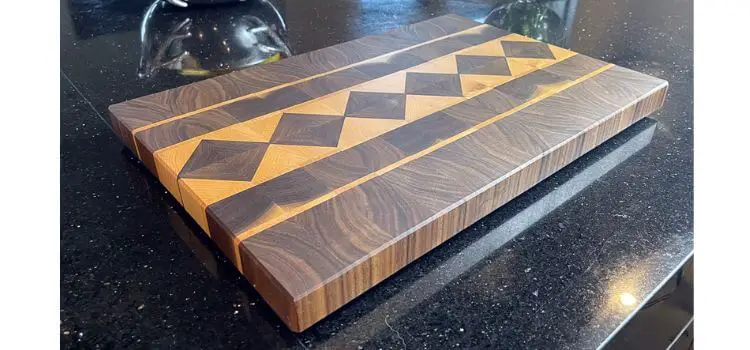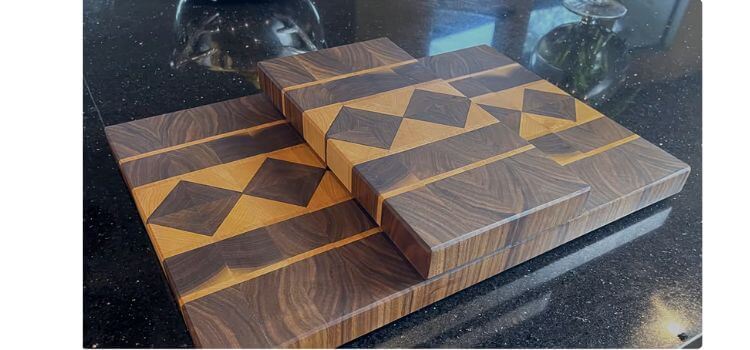Cutting boards are one of those kitchen essentials that most of us don’t think twice about until it’s time to buy a new one. With so many options out there, you might find yourself wondering: is end grain better for cutting boards?
Whether you’re a seasoned chef or someone who just loves to cook at home, choosing the right cutting board can make a big difference in your kitchen experience.
Today, we’ll take a deep dive into the world of cutting boards, focusing on end grain and why it might be the perfect fit for your needs.
What is an End Grain Cutting Board?
If you’ve ever heard the term “end grain” thrown around in conversations about cutting boards and wondered what it means, you’re not alone. To put it simply, an end grain cutting board is made by cutting the wood so that the grain runs vertically. This is different from the more common edge grain or face grain boards where the wood grain runs horizontally.
Imagine you’re looking at a tree stump. The top surface, showing all the growth rings, is what we call the end grain.
When woodworkers use end grain to make cutting boards, they cut the wood into small blocks and then arrange them so that the end grain is facing up. This creates a unique and beautiful pattern, almost like a checkerboard, and gives the cutting board some distinct advantages.

How Does it Differ from Edge Grain and Face Grain?
It’s crucial to understand the difference between end grain, edge grain, and face grain to fully appreciate what makes end grain special.
- End Grain: As mentioned, this shows the top of the wood fibers. When you cut on it, the knife goes between the fibers rather than through them, making it much gentler on your knives.
- Edge Grain: This is made by aligning long strips of wood, showing the side of the grain. It’s more durable than face grain but not as forgiving on your knives as end grain.
- Face Grain: The least durable option, face grain shows the widest part of the wood. It’s more prone to scratches and knife marks, and is generally used more for aesthetic purposes than heavy-duty chopping.
Are End Grain Cutting Boards Better?
This is the million-dollar question, isn’t it? Many people believe that end grain boards are superior, but is that just a marketing gimmick or is there some truth to it? Let’s break down the reasons why end grain cutting boards are often considered the best.
Knife-Friendly Surface
One of the main reasons people swear by end grain cutting boards is that they’re much kinder to your knives. When you chop on an end grain board, the knife slides between the wood fibers instead of cutting through them. This reduces the wear and tear on your knife’s blade, keeping it sharper for longer. It’s like cutting through a bundle of straws rather than chopping across them – much easier, right?
Self-Healing Properties
End grain boards have this magical ability to “self-heal.” No, they won’t regrow like Wolverine, but the fibers tend to close up after you make a cut. This means fewer deep grooves and scratches over time. It’s like the wood has a built-in resilience, always bouncing back and looking fresh.
Durability
End grain boards are tough. They can withstand heavy chopping and even meat cleaving without splitting or warping. This makes them a favorite in professional kitchens where durability is key. Think of them as the heavyweight champions of the cutting board world – sturdy, reliable, and ready to take on anything you throw at them.
Aesthetics
Let’s not forget the beauty factor. End grain boards often look stunning, with intricate patterns that can add a touch of class to any kitchen. They’re not just a tool; they’re a statement piece. It’s like having a piece of art you can chop veggies on!
Hygiene and Safety
The self-healing nature of end grain boards also means fewer crevices for bacteria to hide in. While no cutting board is 100% bacteria-proof, the closed fibers make end grain boards a bit more hygienic than their heavily scarred counterparts.
Drawbacks of End Grain Cutting Boards
No product is perfect, and end grain cutting boards have their downsides too. It’s only fair to weigh these against the benefits to see if they’re the right choice for you.
Price
End grain boards are typically more expensive than edge grain or plastic boards. This is because they require more wood and are more labor-intensive to make. However, many consider this a worthwhile investment given their durability and knife-friendly nature.
Maintenance
End grain boards need a bit more TLC. You’ll have to oil them regularly to prevent the wood from drying out and cracking. If you’re not willing to put in the effort, your beautiful board might end up looking worse for wear.
Weight and Size
These boards tend to be heavier and bulkier. If you’re looking for something lightweight and easy to store, end grain might not be the best choice. They’re built like tanks – great for heavy-duty work, but not so much for quick, casual use.
How to Choose the Right End Grain Cutting Board

If you’ve decided that an end grain cutting board is for you, there are a few things to consider before making your purchase.
Type of Wood
Not all wood is created equal. Hardwoods like maple, walnut, and cherry are popular choices because they’re durable and resistant to knife marks. Maple is often considered the gold standard due to its hardness and closed grain structure, which makes it more resistant to bacteria.
Size and Thickness
Think about what you’ll be using your board for. If you do a lot of chopping, a larger board might be better. For smaller kitchens or more casual use, a medium-sized board will do the trick. Thickness is also a factor; thicker boards are more durable but also heavier.
Finish and Maintenance Requirements
Some boards come pre-treated with food-safe oils or waxes, which can save you some work in the beginning. However, you’ll still need to maintain them over time. Look for a board that matches your willingness to care for it.
Maintaining Your End Grain Cutting Board

Proper maintenance is crucial if you want your end grain cutting board to last a long time. But don’t worry, it’s not as daunting as it sounds.
Regular Oiling
Oiling your board is like moisturizing your skin. It keeps the wood hydrated and prevents it from drying out and cracking. Use a food-grade mineral oil and apply it once a month, or more often if you use your board daily. It’s a little steep that has a big impact.
Cleaning
Never put your end grain cutting board in the dishwasher or let it soak in water. This can cause the wood to warp and split. Instead, wash it by hand with warm soapy water and dry it immediately. If you’re worried about bacteria, you can wipe it down with a solution of vinegar and water.
Sanding Out Stains and Scratches
Over time, your board might accumulate stains or shallow cuts. If this happens, don’t panic. A little light sanding can often restore your board to its former glory. Just make sure to re-oil it afterward to keep the wood protected.
Storage
Store your board upright in a dry place. This helps prevent warping and keeps the board in good condition. Avoid placing it near heat sources like the stove or dishwasher, as the heat can dry out the wood.
Are End Grain Cutting Boards Worth the Investment?
So, after all this information, you might be wondering: are end grain cutting boards worth it? The answer largely depends on your cooking habits and what you value in a cutting board.
If you’re someone who spends a lot of time in the kitchen, chopping, slicing, and dicing, an end grain board can be a great investment. It will protect your knives, last for years, and look beautiful on your countertop. However, if you’re more of a casual cook or don’t want to deal with the maintenance, a simpler edge grain or plastic board might be a better fit.
Conclusion
End grain cutting boards are the cream of the crop when it comes to cutting surfaces. They offer a combination of durability, beauty, and functionality that’s hard to beat. While they do require more maintenance and come with a higher price tag, many home cooks and professional chefs alike consider them to be well worth the investment.
Whether or not an end grain cutting board is right for you ultimately depends on your kitchen habits and personal preferences. But if you’re looking for a board that’s kind to your knives, long-lasting, and downright gorgeous, then end grain might just be the way to go. Happy chopping!
FAQs
What is an end grain cutting board and why is it better?
An end grain cutting board is made from small blocks of wood arranged so that the grain is facing up. This unique structure makes it gentler on knives and more resistant to deep cuts and scratches, making it a preferred choice for many serious cooks.
How often should I oil my end grain cutting board?
It’s recommended to oil your end grain cutting board once a month, or more frequently if you use it daily. Regular oiling helps keep the wood hydrated and prevents it from cracking.
Can I use my end grain cutting board for all types of food?
Yes, end grain cutting boards are versatile and can be used for chopping vegetables, fruits, meats, and more. Just make sure to clean and maintain it properly to prevent cross-contamination.
Are End Grain Cutting Boards More Expensive Than Other Types?
cutting boards more expensive than other types?** Generally, yes. End grain cutting boards are more expensive due to their complex manufacturing process and the quality of wood used. However, their durability and knife-friendly surface often make them worth the investment.
Leave a Reply